Well… as promised… here is the blog I have been saving for later. Well now is later and I have a little time to share interesting true stories of history. WildChild is currently at anchor off the coast of Montserrat with its active volcano. I am a bit frustrated currently because we are in a great anchorage for the usual east trade winds… which… right now… we don’t have. We have rare North winds down here making this place rolly as heck with no protected anchorages on this island for these winds. We are not checked in yet as it is a Sunday and they charge extra for trying to check in outside of normal business hours. So… we are under our Q flag and I am heaving up and down as I write this in these northerly waves.

I do want to caution you, the reader, that this is a BLOG… a personal perspective… and I get to have my own perspective on things… my own personal spin… and if you do not see the world the same way I do… great… no worries… remain calm… feel free to disagree…
___________________________________________________________
The British in Dominica 1782
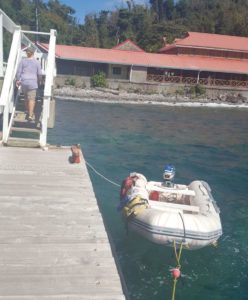
When Wildchild was anchored up in Plymouth Dominica about a week ago mr. Kol told me that there was an old British fort up the hill that we could visit. I just love history and museums and will often go out of my way to visit them, these gems of knowledge that I treasure. So the morning we were going to leave and sail up to Guadaloupe we moved WildChild a mile across the bay and anchored close to the fort, mr. Kol remained behind to guard the yacht in the precarious anchorage and Elena and I took the dinghy over to the forts ferry dock.
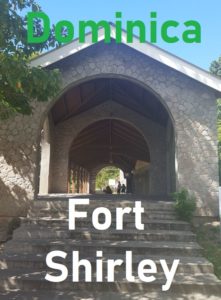
I am endlessly fascinated with the history of these remote Caribbean islands and how their pasts formed them into what they are today. From a purely sociological point of view these separated small countries so close together but formed by such different histories are absolutely fascinating. There can be 2 islands only 30 miles apart so completely different, one thriving and another third world poor, populated basically by the same freed slaves of hundreds of years ago, the same African peoples, same blood, same evolutionary paths, now separated by only a few hundred years of time and a few miles of space. Like rats in an experimental lab, the only difference between the two experimental groups is colonial powers that held over them, then… eventually, one way or another, left them on their own.
Well the primary focal point of all that history lies in a great naval battle between France and Britain 230 years ago down here in the Caribbean.
So let us look at that history with the advantage of getting to see it from both sides, both points of view. Usually history is written, very fictitiously from the winners point of view. Well here we have, beautifully preserved in two separate countries, BOTH sides of the conflict written by each side and preserved from the spin and distortion of modern society.

As we wandered around the old British fort at the north End of Dominica I was struck by the architectural ideas of its time, the thinking behind its construction. So go back in your mind to the time period of the 1700’s. It was not long ago armies fought with bow and arrows and swords from castles. Then the gun powder came along and cannons changed things, changed thinking about how to defend a fort from attack.
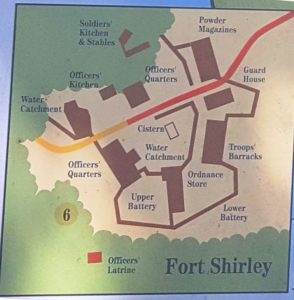
The British evolved their own ideas about how best to construct a fort against the “modern” (1700’s cannon and rifle based) attacks. They started to think about defense differently. A big hill of dirt is very effective against a cannon, a big stone wall is not. Clear fields of fire for your own cannon’s to return fire is good. So the British did not keep building old fashioned castles as they always had in the past. They started spreading their buildings out, using short walls and hills of dirt in front of them to absorb the attacking gunfire.
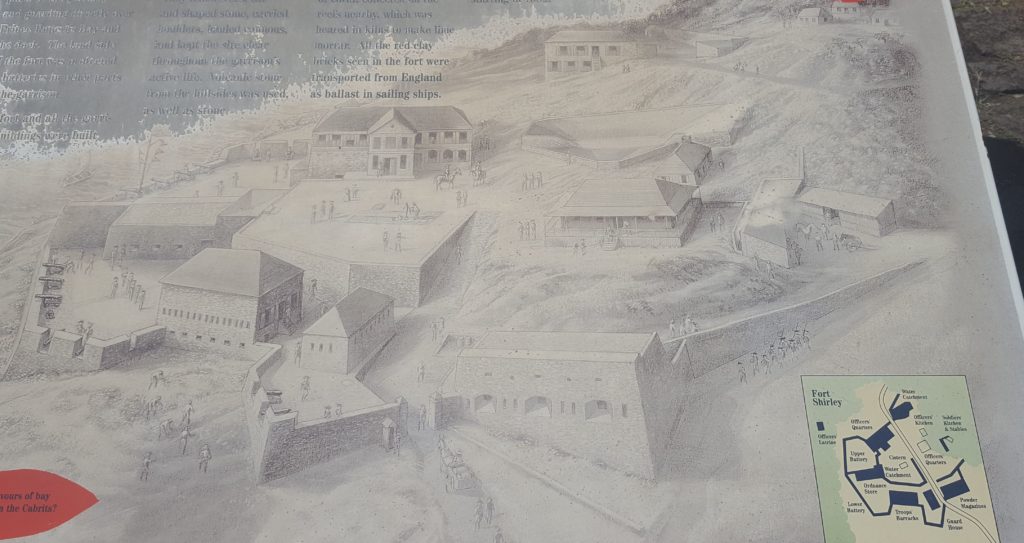
The British had evolved their fort building ideas. As I am Canadian, former British colony, this is what I understood all forts to look like at the time, we have similar forts in Canada and America. The walls are made from very clean cut stone blocks and the buildings are built very sturdy.
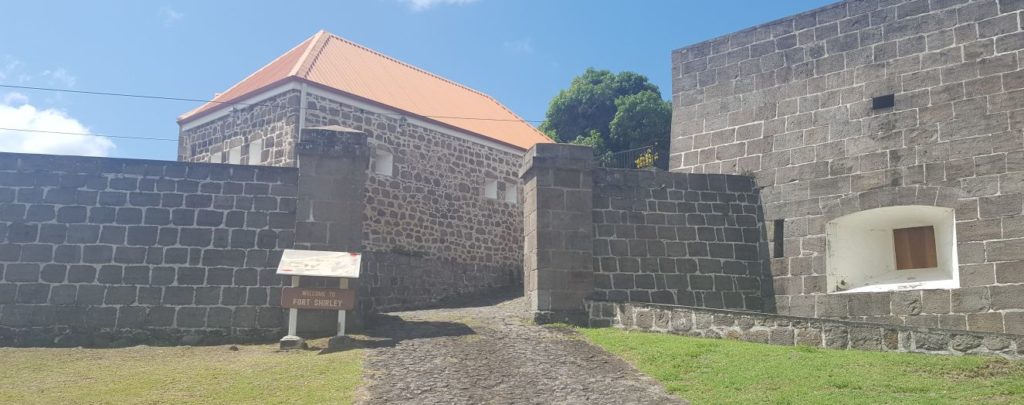
Although we wandered around the old fort there was nothing too weird about its construction. We admired how organized the place seemed, how clean and how efficient the designs. The only thing that struck me as odd… was the murder holes seemed inverted. Look at that white looking “window” in the pic above. That is a murder hole. They idea is that the person inside the building with the rifle could be protected and hold their rifle out the window and still angle it around for the widest field of fire at the enemy. What interested me though… was that it seems inverted. Any incoming fire that enters the outside frame of the box will ricochet towards the defender standing inside, thus providing less protection. I am of course no military expert.
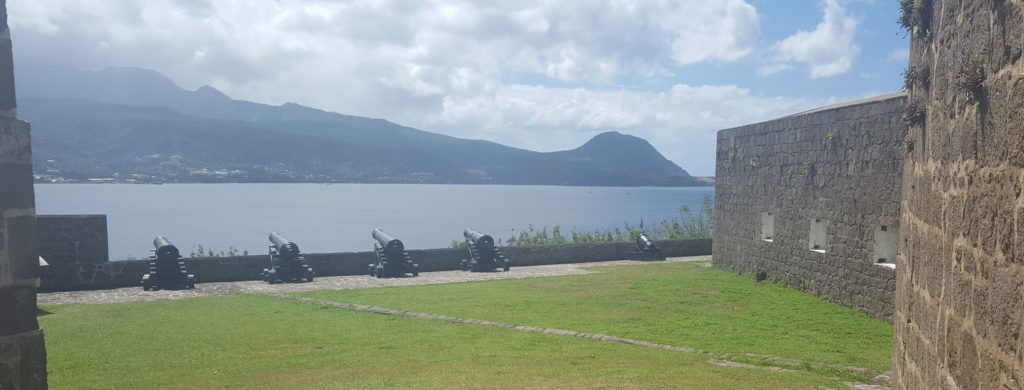
As we walked around the grounds you can just imagine what it must have been like to be a soldier stationed here hundreds of years ago. You can just admire how much work this fort took to construct. You can imagine the engineers designing it with a military eye.
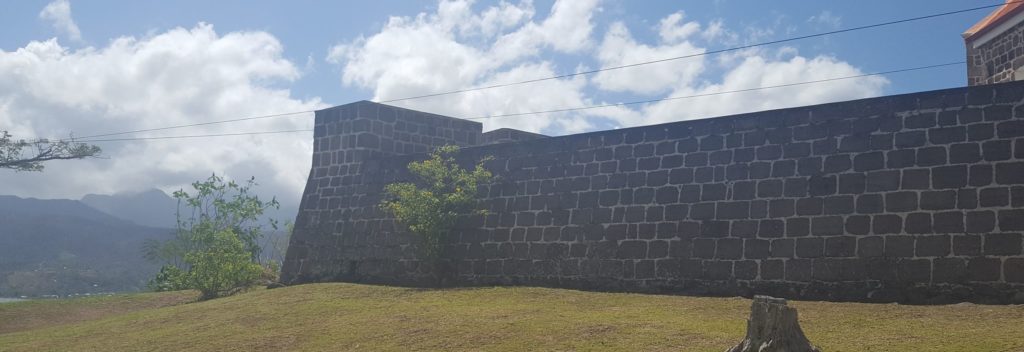
Then there is the preserved history. It seems Canada helped the Dominicans with this too. Canada helped provide them these beautiful displays with articles and artifacts capturing the past.

This is the written history from the British point of view.
It seems that in 1782 the British naval fleet faced off against the French Naval fleet for dominance of these islands in a great battle north of this fort and island. But I will get into the fascinating details of this history a little later.
Let us look at the French fort now…
_______________________________________________________
The French in Guadaloupe 1782
It was two days later that WildChild was at anchor in the southern french islands called isles de saints. Again mr. Kol in his wanderings found another fort, but as it was a Sunday, it was not open. So Monday morning, after checking into Guadaloupe we all made the hike up the hill to go check out the fort.
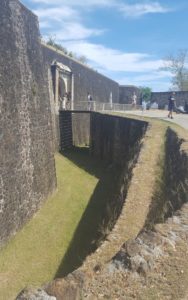
There was a nice road leading up the hill to the fort. After walking up the hill we came around the corner to discover a magnificent old style castle complete with a moat and draw bridges.
What just amazed me is that it was a castle. The French idea of forts had not evolved with the times. They learned nothing from the advent of the cannon and its effects on brick walls. They still had tall skinny murder holes designed to allow archers room for their bows to launch arrows.
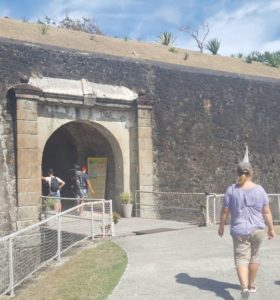
Although I was immensely impressed with this formidable structure I was completely shocked that it was designed exactly as the French had been building castles for hundreds of years previous. They made few accommodations for the change in military technology. There was no fusillades for the cannons, there were very few cannons. They seemed rather unconcerned with defending the bay but more concerned about men storming the castle. They felt like they could safely just hide inside the protection of the stone walls. The cannons of the times would have just pummeled these walls to rubble from the attacking ships in the bay. The collapsing walls would have filled up the moats giving the foot soldiers easy access to storm the keep.
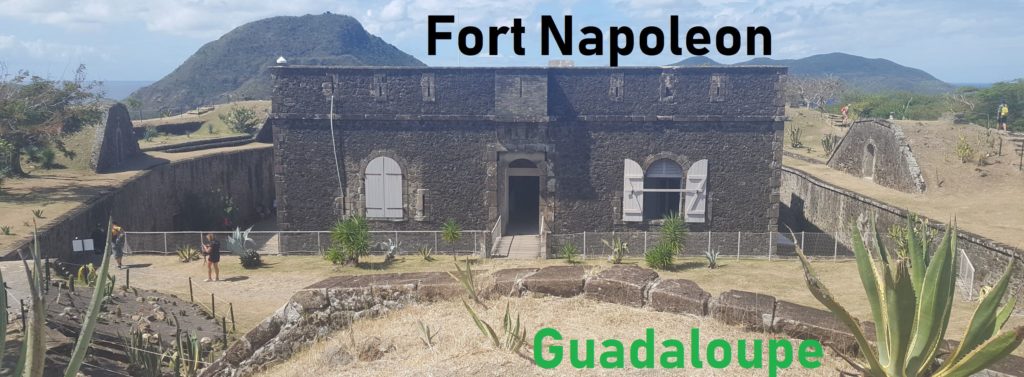
The thinking in the design is so very French. If you ever take some time to study french history, understand why they keep having so many French revolutions, why they keep losing every war, you will find the root of this is the inflexibility of their power hungry old men rulers to adapt to change. Although my point is not to prove this to you here, it is very evident here in the design layout and history of this fort. It is just dripping with French culture. I found it so fascinating I could not walk away for hours. I was slack jawed with amazement. The leaders were very worried about being able to hide safely if the enemy ever showed up. So French… so funny.
There are no cannons and no fusillades to provide any cannons with open clear fields of fire over the bay. This fort would have been very ineffective at actually defending its ships in the bay below. I could not even figure out what the function of this fort was other than to just protect the rich men of power in the event of an invasion. It would not even have been very effective at this task as the attacking cannons would have easily reduced its walls to rubble.
French thinking of its time… just FASCINATING…!
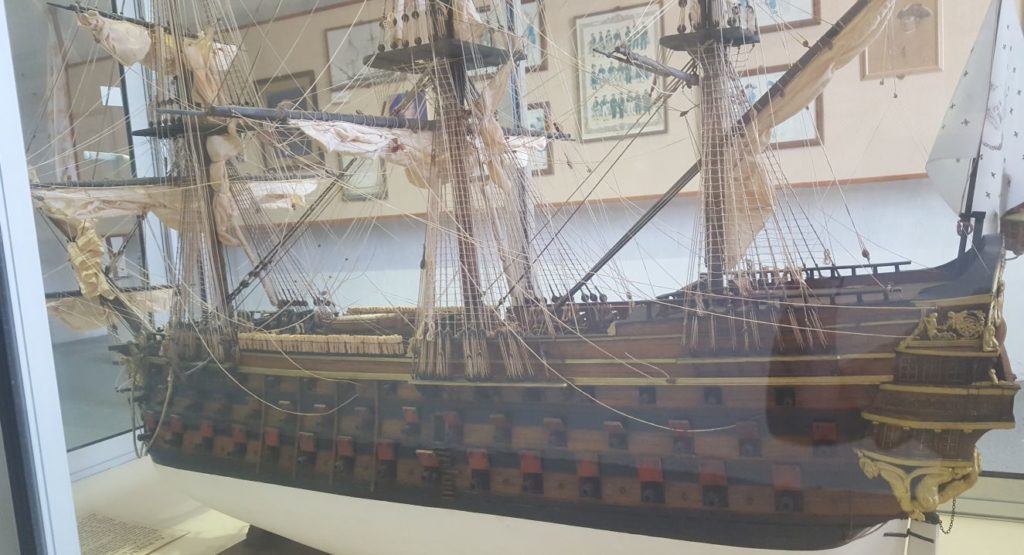
Inside the castle keep is a spectacular museum full of fabulous displays and artifacts of the past. There were terrific scale models of the ships they used in those days to fight the great battle here.
_____________________________________________________
The Big Battle
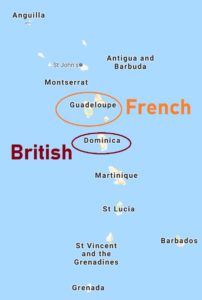
Now this following account of the battle is made up mostly of the agreed upon facts combined from both forts. Please forgive me as this is a very short and fast summary of the battle not intended as legal facts but merely to give you, my reader, a basic understanding.
So to give you a basic background understanding…
These islands were being fought over by the 3 great colonial super powers of that time… England, France and Spain.
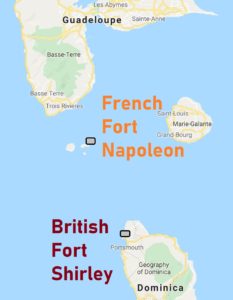
Several years earlier the french fleet had humiliated the British fleet in America locking them up in the Cheasapeak bay and enabling the rebelling Americans to defeat the British. England was furious about this humiliation and wanted to get revenge on France for this defeat. Years later they found their opportunity down here in the Caribbean.
The British had a strong hold south in Dominica in fort Shirley and with its protection over the bay I showed you at the top. They amassed a fleet there in winter 1782.
The French control over these vital trade islands was being threatened. The French, using the natural safe harbour formed around the isles de saints south of Guadaloupe had a stronghold in fort Napolean I just showed you. The french rallied its navy here in their stronghold.
On April 12th 1782 there were 36 British ships that sailed up north to engage the French fleet. There were 30 French ships that sailed south that morning in response to the invasion.
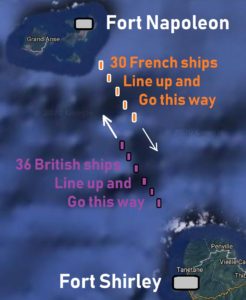
So to understand, at that time, for a great naval battle like this, they sailed their ships single file, 200 foot long ropes tied bow to stern between them. The two sides sailed their lines in opposite directions and just let loose their cannons and pounded the living crap out of each other. Who ever had the most surviving ships at the end won.
However… if you could capture the opposing admiral’s flag ship… and force him to surrender… then the rest of his army would follow suit… even if they were winning everywhere else. Because…. of course… the leaders of these battles should not themselves be killed in the fight.
April 12th 1782 10am…
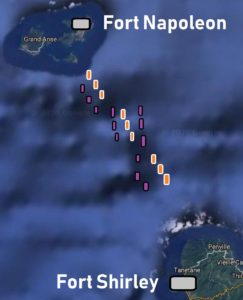
The wind drops, not helping the French as they are approaching Dominica, creating havoc in their lines of battle.
The British ship the “Formidable” flying admiral Rodney’s pennant, prompted by her captain sir Charles Douglas, abandons, purposely, for the first time in maritime naval history, it’s formation in the line and cuts thru the french lines in the middle just behind the French Admiral’s flag ship isolating her from the French lines.
In the south, Hood, the captain aboard the “Barfleur” cuts between the “Cesar” and the “Dauphin”.
April 12th 1782 11am…
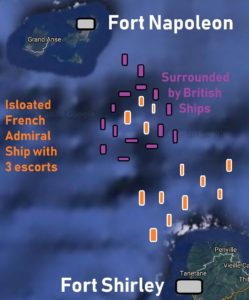
The French fleet is cut in the center and the French admirals flag ship “Ville De Paris” is isolated with only three other supporting ships that came to the admirals aide.
The British tactic of cutting the French lines enabled them to rake both sides of the French ships caught in between the British ships with their cannons.
As the afternoon battles wore on and the wind died away many of the French ships lingered, damaged and becalmed, south of the battle, ineffective and useless.
The French admiral’s flag ship got completely surrounded by the British and many of the British ships, north, had already turned around to rejoin the battle before the winds died.
The FRENCH LOST the biggest naval battle of the new world.
You can see how their leaders fought the battle exactly as they always did, they used the same old tactics they always used, inflexible and slow to adapt to change… the French way.
. *************** .
Now this kind of history in itself is endlessly fascinating to me… I was brief in my descriptions here because I am cognizant that, perhaps, you are not so interested in military naval history. So please allow me to cut straight thru to the interesting part I discovered.
According to the British history museum in Dominica….
…. the British won the battle because of their daring and innovative battle plan and new naval tactics….
According to the French history museum in Guadaloupe…
….. they (the French) only lost due to bad luck when the wind died… completely not their fault.. they were not to blame they just had bad luck…
INTERESTING HUH…..?
So many different versions of reality even way back then. Trump is not the first leader to learn about the importance of “SPINNING” the truth.
Okay my sailor children… enough stories for today… time for bed…
Captain Lexi….
. …….. the infinitely curious …..
